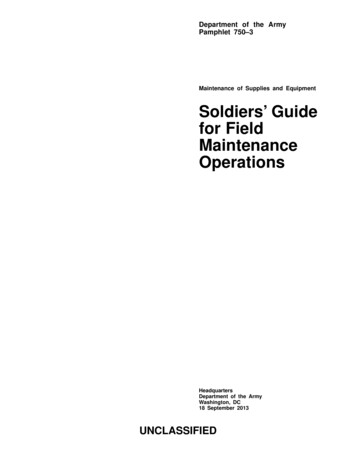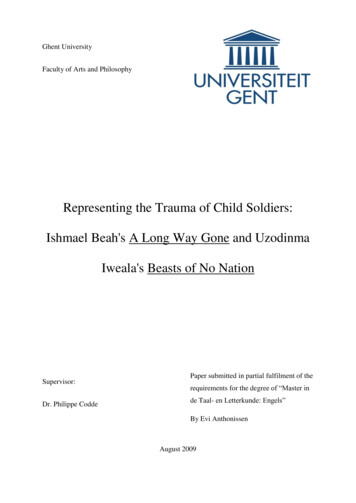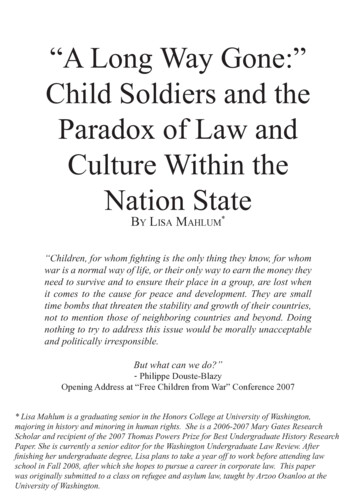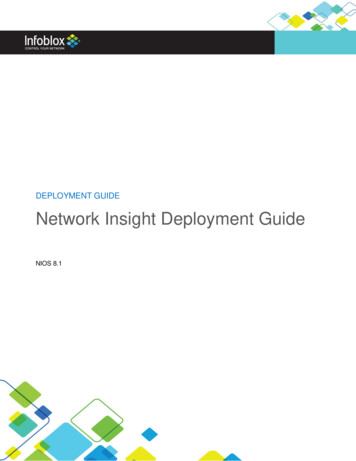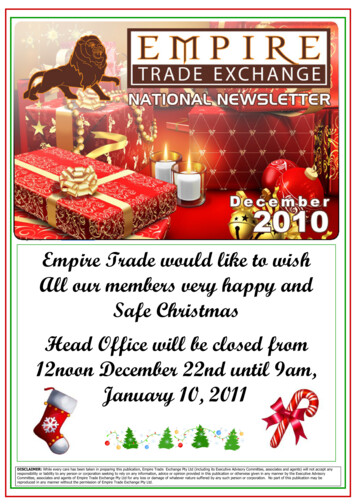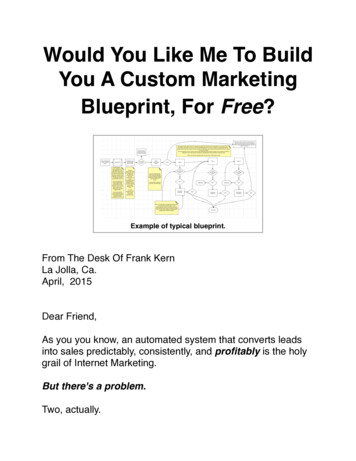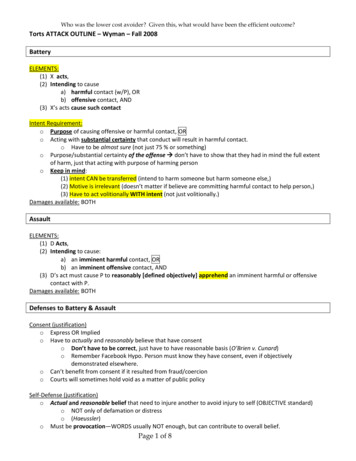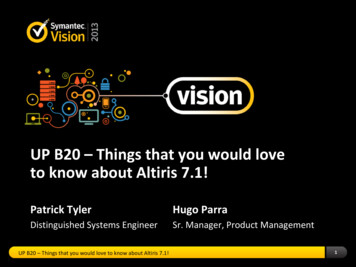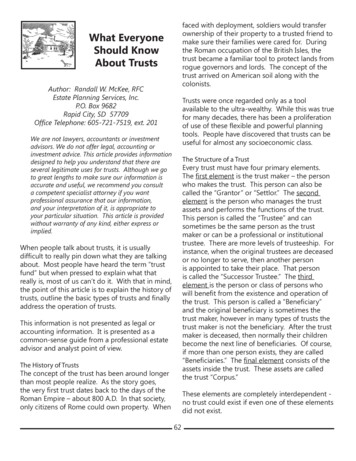
Transcription
faced with deployment, soldiers would transferownership of their property to a trusted friend tomake sure their families were cared for. Duringthe Roman occupation of the British Isles, thetrust became a familiar tool to protect lands fromrogue governors and lords. The concept of thetrust arrived on American soil along with thecolonists.What EveryoneShould KnowAbout TrustsAuthor: Randall W. McKee, RFCEstate Planning Services, Inc.P.O. Box 9682Rapid City, SD 57709Office Telephone: 605-721-7519, ext. 201Trusts were once regarded only as a toolavailable to the ultra-wealthy. While this was truefor many decades, there has been a proliferationof use of these flexible and powerful planningtools. People have discovered that trusts can beuseful for almost any socioeconomic class.We are not lawyers, accountants or investmentadvisors. We do not offer legal, accounting orinvestment advice. This article provides informationdesigned to help you understand that there areseveral legitimate uses for trusts. Although we goto great lengths to make sure our information isaccurate and useful, we recommend you consulta competent specialist attorney if you wantprofessional assurance that our information,and your interpretation of it, is appropriate toyour particular situation. This article is providedwithout warranty of any kind, either express orimplied.The Structure of a TrustEvery trust must have four primary elements.The first element is the trust maker – the personwho makes the trust. This person can also becalled the “Grantor” or “Settlor.” The secondelement is the person who manages the trustassets and performs the functions of the trust.This person is called the “Trustee” and cansometimes be the same person as the trustmaker or can be a professional or institutionaltrustee. There are more levels of trusteeship. Forinstance, when the original trustees are deceasedor no longer to serve, then another personis appointed to take their place. That personis called the “Successor Trustee.” The thirdelement is the person or class of persons whowill benefit from the existence and operation ofthe trust. This person is called a “Beneficiary”and the original beneficiary is sometimes thetrust maker, however in many types of trusts thetrust maker is not the beneficiary. After the trustmaker is deceased, then normally their childrenbecome the next line of beneficiaries. Of course,if more than one person exists, they are called“Beneficiaries.” The final element consists of theassets inside the trust. These assets are calledthe trust “Corpus.”When people talk about trusts, it is usuallydifficult to really pin down what they are talkingabout. Most people have heard the term “trustfund” but when pressed to explain what thatreally is, most of us can’t do it. With that in mind,the point of this article is to explain the history oftrusts, outline the basic types of trusts and finallyaddress the operation of trusts.This information is not presented as legal oraccounting information. It is presented as acommon-sense guide from a professional estateadvisor and analyst point of view.The History of TrustsThe concept of the trust has been around longerthan most people realize. As the story goes,the very first trust dates back to the days of theRoman Empire – about 800 A.D. In that society,only citizens of Rome could own property. WhenThese elements are completely interdependent no trust could exist if even one of these elementsdid not exist.62
of the terminology before you can have anunderstanding of what these trusts can or cannot do.Types of TrustsTrusts can be formedin literally thousands ofconfigurations. The uses arealmost unlimited. Despitethese almost limitlesspossibilities, there areonly four major types of trusts – Revocable,Irrevocable, Testamentary and Living. Someadvisors would mention Domestic trusts andOffshore trusts, but even these must fit withinthese four classifications.Common Uses for Different Types of TrustsWhile we’re discussing the common uses fortrusts, let’s address the most common type oftrust first – the Revocable Living Trust.For most families, this trust acts much like aWill – its primary purpose is to distribute assetsto the beneficiaries after the trust’s makers aredeceased. That’s about where the similaritiesbetween the Will and revocable living trust end,however.Revocable TrustsThis type of trust can be amended, added to orrevoked during its maker’s competent lifetime.After the maker is deceased, this type of trusttypically becomes irrevocable.The revocable living trust’s ability to avoidprobate is often the primary reason families usethem for distributing assets. Many generalistattorneys argue against making a revocableliving trust and encourage their clients to havetheir estates settled through the probate process.This mindset is in direct conflict with the nationalorganizations that support specialist estateplanning attorneys. The National Network ofEstate Planning Attorneys supports the notionthat most people benefit from a revocableliving trust – based estate plan. The AmericanAcademy of Estate Planning Attorneys lists therevocable living trust as its number one estateplanning strategy.Irrevocable TrustsThese trusts can’t be changed after they aremade. There are many uses for irrevocabletrusts – like funding legacies for children orgrandchildren. Others might use an irrevocabletrust to make gifts of property or life insurance.Testamentary TrustsThis is the type of trust that is typically includedin a person’s Will. A testamentary trust goes intoeffect only after its maker has deceased. Thistrust could also be considered a revocable trustbecause your Will can be changed at any timeduring your lifetime.Why does a revocable living trust avoid probate?That’s a good question. The answer is thatall of us are not going to be living at somepoint in the future. If we have assets titled inour names, then those assets will need to beprobated so they can go to our heirs. If we havea revocable living trust, the assets are alreadyout of our name. And even though we will allbe deceased at some point, the trust lives on. Inessence, when you fund your living trust (retitleyour assets into the name of your trust), youhave performed what some refer to as a “livingprobate.”Living TrustsAny trust that takes effect during the maker’slifetime is considered a living trust. Most people– and sometimes even legal professionals –misinterpret the distinctions presented here.People are often heard talking about “livingtrusts” when they really mean “revocable trust.”Sure enough, the revocable trust is typicallya living trust, but irrevocable trusts are veryfrequently living trusts, too!The distinction here is important becauseyou need to have a thorough understanding63
who put her very personal information in theparents’ Wills. There is frequently other veryprivate information contained in probate filesthat families would prefer to keep private.Why Should You CareAbout Probate?The estate planningcommunity consists ofprofessionals knowledgeableabout estate law andregulations. The professionalestate planners and lawyers steer clear of thepro and con debate over probate. Most of thespecialists would prefer that their clients’ estatesnot be exposed to the probate process. Thereader should note that even though there arereasons why specialists don’t want their clients’estate exposed to probate listed here, not everypotential problem listed will occur in everyprobate.Formal probate provides very little or no flexibility.The process to complete a probate is written inlaw. There is very little or no flexibility in a formalprobate. However, the adoption of the UniformProbate Code has provided much more flexibilityon estates that can be settled by informalprobate.During the probate process, it is relatively easyto challenge the Will. Any family member andeven some people who are not consideredfamily members can challenge the Will. MostWill challenges are not successful, but can leadto messy family fights in the public court forum.Challenges make the settlement process takelonger, cost more money and add aggravation toeveryone involved.Probate can be time consuming. It can takeanywhere from four months to several decadesto complete a probate. The national averageis somewhere around thirteen months. Manystates have passed the Uniform Probate Codeto simplify and standardize informal probateproceedings and this has had a very positiveimpact on the process.Probate can be expensive. It is almost impossibleto find anyone who can tell you how much itcosts to probate an estate. Some states havethe rate set in law. In other states, attorneys,accountants and others charge whatever theywant to charge. The issue is that there is noway one can predict what a probate might cost.National estate planning expert and authorHenry Abts III, in his book The Living Trust,writes that you can expect five percent to fifteenpercent of your estate to be gone after theprobate process is completed.Probate can make it expensive to manage aninheritance for a disabled heir. When a disabledperson inherits an asset, there are several issuesthat may make that inheritance ineffective. Thefirst is the disabled person’s ability to managethe asset. The second is the inheritance oftendisqualifies the disabled heir from governmentprograms they might be on. To avoid this,another person may be appointed as a guardianor conservator of the disabled person’s estate.This process can and often does lead to familyfights.Probate can’t protect an inheritance fromcreditors. Once a person receives an inheritanceout of a probate estate, that asset can beconfiscated and applied to any judgment,including IRS liens and judgments from creditorsor former spouses.Probate is a matter of public record. Some peopleare really shocked to discover that their parents’wills and other private financial and businessinformation become a matter of public recordas soon as their estate is presented for probate.Some Wills even have the date of birth andSocial Security numbers of the heirs published inthese public files! One recent discovery of thisfact had a client particularly angry at the attorneyAdvantage – Once Probate Is Done – It’s DONEOnce a probate is closed and over, it is done.Ordinarily, creditors are not allowed to make64
distributions.any more claims against theestate. With a revocableliving trust, legitimatecreditors typically have thelength of time outlinedin that state’s statute oflimitations laws to challengespouse to take over the trust entirely. Obviously,the larger estates with federal estate tax issueswill require far more work than just signinga couple documents. However, the properlyfunded trust still avoids the potential headachesof probate.A national estate planning expert recently statedthat most of his clients’ trusts can be settled withonly a couple of hours of work. Of course everyplanner has a different system, but specialists canattest that revocable living trusts are normallyvery easy to settle.When you compare the probate process to thebenefits of a revocable living trust, it may bequite easy to determine what might work bestfor you. In contrast to a Will, a revocable livingtrust is: Normally inexpensive to settle. One ofthe arguments against making a revocable livingtrust is the initial cost. While it is true that mostattorneys charge more to draft a trust than theydo to draft a Will, the savings are very frequentlyoffset by the savings when the probate fees andcosts are eliminated. This is not to say that therevocable living trust can eliminate settlementcosts entirely. For instance, if an estate wouldneed an appraisal for federal estate tax purposes,that appraisal would still have to be done. Ifan estate distributed by a Will would need anextensive amount of accounting work done,the same estate distributed by revocable livingtrust would probably need the same amount ofaccounting.Revocable living trusts are private. There is noprobate file for strangers to look at. The trustis completely private and is only for the eyes ofthose involved – trustees and beneficiaries.Revocable living trusts are flexible. The trustmakers can write in all the flexibility that theythink is prudent. In reality, most of the moderntrust drafting programs have standard languageattorneys use to provide flexibility and control,but each trust must be customized to meet theneeds of the trust makers.Trusts are more difficult to challenge. The debaterages on over this statement. As our societyis forced to become more and more legalized,many people have endured the rude awakeningthat there is no way to avoid being sued. Inmost states, trusts are under the same scrutinyas are Wills – and the scrutiny lies with two majorissues. The first issue is mental competency –did the person writing the Will or trust have themental capacity to make that document. Thesecond issue is undue influence – did a personwho got a larger share of inheritance have anundue influence over the person writing theWill or trust. A mediation/arbitration clause canhelp keep the trust’s affairs out of the theatricsof the courtroom and a no-contest clause canhelp keep troublemakers from causing mischief.There are more explanations about these andother clauses later in this article.However, if an estate would not need any ofthese types of extra work conducted, trustsettlement costs can be significantly lower thanestate settlement costs through a Will. Oneissue that needs to be pointed out here is theeffectiveness of any trust in probate avoidance isgauged directly by the quality of the “funding” ofthe trust – or having the assets titled in the nameof the trust. If you have a trust that has notbeen funded, what you really have is expensivescratch paper. Assets must be titled in the nameof the trust for the trust to be an effective estatemanagement and probate avoidance tool!Normally easy to settle.When one spouse is deceased, it is very typicalfor a surviving spouse to just sign just a coupleof legal documents and that allows that surviving65
Revocable living trusts canmake it easier to manage adisabled heir’s inheritance.The trust maker states exactlyhow all the heirs’ inheritancesare handed down. Thereare literally many differentvariations of how inheritances can be distributedand managed. This is not only true for disabledheirs, but also for all heirs. If an heir had alien placed against them by any person orgovernmental agency, the trustee of the trustcould pay for the benefit of that heir insteadof just distributing money. In other words, aproperly written and operated trust could allowthe trustee to buy a house and let that heir livethere. The trustee could buy a car for that heir’suse. The trustee could pay medical bills, energybills, provide vacations and provide relief for avariety of other expenditures. Of course, thetrust has to have the proper language and beoperated properly for the heirs to enjoy this levelof asset protection.and then how the assets are to be distributedwhen they are deceased. There are several waysto retitle assets in the name of the trust. Realestate is typically deeded into the name of thetrust. Personal property that does not have atitle is transferred into the name of the trustby assignment or bill of sale. Titled assets, likevehicles, bank accounts investment accounts,stock certificates, etc. are simply retitled. Wetypically don’t want to retitle qualified accountssuch as IRAs, 401(k)s, TSAs, etc. into the name ofa trust, but the properly worded trust can be abeneficiary of qualified accounts. Even though atrust maker has retitled assets into the revocableliving trust’s name, the trust maker still maintainscomplete control of the assets.Normally, in a situation where a couple makesa trust their lives do not change one bit. Theystill have complete control of the assets. Theystill file the same income tax returns. They stillmaintain the same tax ID number on their bankaccounts. They do not even have to change thename on their check blanks if they don’t want to.Revocable living trusts can be an essential pieceof keeping the family peace, especially in secondor subsequent marriages. Most matrimonialattorneys want their clients to execute prenuptialagreements to avoid major problems later on.Estate planners are seeing more and more caseswhere “blended” families are at odds with eachother. By far, the best way to deal with this isto use a revocable living trust that outlines veryclearly what is to happen with assets. Typicallythe spouses want the entire trust assets availableto support the surviving spouse, but may wantthose assets distributed to their own childrenafter the surviving spouse passes.During their lives, all of the assets in the trustare used to support the surviving spouse duringtheir lifetime. Then, after both spouses aredeceased, the property is distributed to theheirs. During the spouse’s lifetime, the trust istypically still amendable and revocable. In somecases, however, the trust can become irrevocableon the death of the first spouse to pass. Whathappens depends on what is written in the trustdocument.Estate Tax AvoidanceOver the decades, there has been much ballyhooover the federal estate tax. One author recentlywrote that the federal estate tax has been“permanently repealed” three times! The realityis that even though many people would like tosee this tax repealed, it will always be a politicalfootball. After all, when the government needsmoney, who is the easiest mark? Dead peopledon’t vote or complain or give money to politicalopponents.How Does A Revocable Living Trust Work?Now that we have addressed the primarydifferences between the probate process (Willor nothing) and the revocable living trust, let’saddress how a revocable living trust works. It’svery simple.A person making a revocable living trust decideshow their assets will be used when they are living66
Whether you support thefederal estate tax or not, youwill always have the abilityto avoid all of it if you reallywant to by using legitimateplanning techniques whichinclude splitting the revocable trust into twotrusts at the first death of a trust maker to takeadvantage of the automatic estate exclusionamounts, currently known as the ApplicableExclusion. The term that applied to this conceptwas, for many years, referred to as the UnifiedCredit.or institutional trustee, such as a bank trustdepartment.Making these two trusts is a function of utilizingseveral benefits all under one umbrella. Asyou read earlier, we can split an estate with thismechanism to make sure that the deceasedspouse’s lifetime exemption is utilized. We canalso use this A-B arrangement to put rapidlygrowing assets in the B trust, so the estategrowth takes part outside of the survivingspouse’s estate. The Trustee of the B trust cantake cash inside of the trust and purchase lifeinsurance on the surviving spouse, so the wealthis leveraged for the beneficiaries on an incometax free basis.Some trusts include provisions that instruct theSuccessor Trustee to automatically protect thedeceased spouse’s Applicable Exclusion. TheApplicable Exclusion is the amount of assets aperson can own at death before their estate issubject to federal estate taxation. For tax year2006, this exclusion for each deceased person is 2 million. So if a family had an estate that wasnear 2 million or over that amount, they wouldwant a trust that had a provision to utilize thedeceased person’s lifetime exclusion. This typeof sub- trust is sometimes called the “BypassTrust,” or “Credit Shelter Trust.” Sometimes thistrust is called the “Decedent’s Trust.” The entirepoint of this sub-trust is to utilize the deceasedperson’s lifetime exclusion amount and reduce oreliminate federal estate taxes.The A-B Trust ArrangementIf the Bypass Trust is used, then we have whatwe call an A-B Trust arrangement. It is easy toremember which trust is which. The A trust isfor the above-ground spouse and the B trust isfor the below-ground spouse. When the firstspouse passes and the B trust is funded, the Btrust becomes irrevocable – the terms of thetrust can not be changed. The A trust is typicallycompletely amendable and revocable by thesurviving spouse. The surviving spouse typicallyremains as trustee of the A trust. Many differentpeople or institutions could act as trustee ofthe B trust. Most families appoint a child orchildren to serve as trustees after the parents aregone. Others can appoint professional trusteesWe want to take great care when constructingan estate plan with the A-B trust. Although thesurviving spouse can have some limited controlover the assets in the B trust, there is not nearlyas much control over these assets as there oncewas. The surviving spouse has complete controlover the assets in the A trust, however.Why does the surviving spouse lose most controlover the assets in the B trust? It has to do withwhat the IRS calls “Power of Appointment.”Basically, a person with power of appointmentover an asset in a trust is the owner of that assetfor federal estate tax purposes. In essence, ifthe surviving spouse could appoint any and allassets out of the B trust, all of those assets wouldbe included in that spouse’s estate when theydeceased, probably causing much waste fromestate taxes and the administrative work requiredto file the Form 706 (Federal Estate Tax return).67Potential Problems Funding the A-B TrustWhen the first spouse deceases, a decision mustbe made on which assets to place in the A trustand which to place in the B trust. We call this“funding” the trusts. As you will recall, whenwe originally made the first Revocable LivingTrust, we had to change the titles of the assetswe owned to the name of our trust, thereby“funding” it. Now we get to do it again. This isnot a difficult chore.
assets that are “disclaimed” by the survivingspouse. By operating the trust this way, we canensure that the surviving spouse gets to keepcontrol over the maximum amount of assets thatmake the most sense for their case. So in thiscase where the family had 2.25 million is assets,the surviving spouse could fund the B trust withthe fastest-growing assets and retain control overthe liquid assets and depreciating assets.The difficult part of thisprocess is deciding whichassets go where. Because wewant the surviving spouse tobenefit from all the assets inthe estate, we need to makesure there is control over the assets the survivingspouse wants control over. For instance, if aranch had land worth 2 million, cattle andequipment worth 1.5 million and cash worthabout 500,000, the surviving spouse wouldprobably want the land placed in the B trust andthe cattle, equipment and cash placed in theA trust. This way, the surviving spouse has themost flexibility with the most liquid assets, theheavy land value appreciation is probably takingplace in the A trust, and the depreciating assetsare in the A trust.Because this is a state-of-the-art arrangement,it also requires a state-of-the-art plan that isput together by someone who knows whatthey are doing. It is not difficult to operate thisstrategy, but the right steps have to be taken atthe right time. Many attorneys shy away fromthis arrangement because they either don’tunderstand how it works or they don’t want theburden of having to keep track of the fundingprocess. Most specialists, however, point outthat this is often the best of what we can offerto families. It is important to note that usinga qualified disclaimer falls under certain rulesthat have to be adhered to or risk losing theexemption! If you use this strategy, it shouldonly be with the help of a qualified estateplanning specialist.The only changes required in this arrangementwould be to change the deeds to read that theland is owned by the B trust. Ownership mightread like this: Grantee: The John and Jane DoeFamily Trust, Credit Shelter Trust or The John andJane Doe Family Trust, Decedent’s Trust. Thename of this trust depends on how the maintrust document refers to it.One Trust or Two?One of the more popular misconceptions aboutlarger estates is the notion that in an estate thathas a potential estate tax liability, two trustsare needed – one for the husband’s assets andone for the wife’s assets. It is rare to find anarrangement like this done by specialists today.There is still an occasional occurrence where twotrusts are better than a joint trust. There aretwo major reasons why specialists don’t maketwo trusts any more. First, the surviving spousecan lose control over too many assets. Second,there is potential for a major lack of flexibility infunding the trusts.Some trusts have a forced funding of the B trust.In the event a spouse passed, the trust wouldrequire the trustee to fully fund the B trust withthe maximum amount allowed by law. So in theyear 2006, if a person passed and their trust hadthis clause, a mandatory funding of 2 millionin assets would be required to be placed in theB trust. This is all fine and dandy, except in theevent the estate is only 2.25 million. Essentially,that would mean the surviving spouse might losecontrol over all the assets but 250,000. Oncethe surviving spouse finds out about that, theyare usually not very happy. There is a better wayto do this, and it is called a “Disclaimer” trust.Here is an example: Let’s say that Mr. and Mrs.Doe have gone downtown to their lawyer andhe has made them two trusts. The lawyer hasfunded Mr. Doe’s with the ranch land, half theA Disclaimer trust is really a state-of-the-artestate planning arrangement. With this typeof trust, the trustee only funds the B trust with68
cattle and half the money.The lawyer has funded Mrs.Doe’s trust with a smallacreage close to town, halfthe cattle and the money.As they aged, Mr. and Mrs.Doe discovered that none oftheir children wanted to come back and ranch.Just prior to Mr. Doe’s death, they had begunnegotiations with the neighbor to sell the ranchland for a premium price. The Does’ oldest sonis named as trustee of Mr. Doe’s trust and isreally not looking out for his mother’s interest.As Trustee, he now decides when and if thatland is sold. Even though Mrs. Doe wants tosell the place, she may no longer has a real sayin the matter. The son, as Trustee, is obligatedto perform the trust, but probably has widediscretion in the disposition of the trust as longas he keeps the trust assets safe and productive.In contrast, if the Does had made an A-BDisclaimer trust, Mrs. Doe could have disclaimedother property into the B trust and then havethe ranch land in the A trust and finally sold theland inside the A trust. That gives her maximumflexibility and control.is managed for one mentally disabled childand the last share managed for the benefit ofthe children of a deceased child. Sometimespeople leave a portion of their trust estate toprovide a scholarship or other ongoing supportfor a worthy organization. The managementpossibilities when using sub-trusts are almostlimitless!Trust ClausesEvery trust consists of a series of paragraphs orgroups of paragraphs. These paragraph groupsare called “Clauses.” Clauses are the tools thetrust drafter uses to make sure the trust makersget what they want. Here are a few of the mostwidely–used clauses that can be used in almostevery trust:Mental Competency Clause: This clause instructsthe Successor Trustee to have the original trusteeexamined if there are serious concerns aboutthe original trustee’s mental competency. Itis common to have the person examined by aregular doctor, a neurologist and a psychologist.The entire point of this clause is to avoid thepublic nature of a competency hearing. If theoriginal trustee is found to be not competentby consensus of the examination team, thetrusteeship automatically transfers to theSuccessor Trustee with no need for a court ordersecured through conservatorship hearings.Many non-specialist attorneys want to maketwo trusts because they can generate two trustdrafting fees. Others don’t want to keep track offunding an A-B trust. Still others are not up tospeed on the A-B trust, so their clients get whatthe attorney wants them to get. What is bestfor you? Well, only you can make that decisionafter your specialist estate planner or estateplanning attorney gives you the proper amountof information to make an informed decision.No-Contest Clause: This clause clearly statesthat any beneficiary of the trust who challengesthe distribution of the trust is automaticallypunished – typically by losing part of all oftheir inheritance. This clause is usually usedto discourage any mischief from disgruntledheirs and/or their spouses. When properly andaggressively enforced, this clause can put an endto challenges.Other Sub-TrustsA family trust can have a variety of subtrusts. These sub-trusts are typically meant toserve individual heirs who are not capable ofmanaging their own affairs – such as a mentallydisabled child or a child who has drug oralcohol dependency or even a spendthrift child.So it would be possible in a family with fivechildren to have shares of the trust distributedoutright to three children, while another shareMediation/Arbitration Clause: This clauserequires that any and all disputes regardingthe trust be handled in mediation and bindingarbitration. The reason more and morespecialists are using this clause is to removethe supervision of the trust from a frivolous69
Distributions to Disabled Persons Clause:This clause instructs the trustee on how toproceed with distributions to a disabledperson. Very often, if a disabled person isreceiving government benefits, an inheritancewould disqualify them. Typically, the trustee isinstructed to give the disabled beneficiary justenough to keep them qualifying for benefits.and ineffective court systemthat is often based ontricks, harassment, discoverand courtroom tactics andplace the dispute under theauspices of an arbitrationsystem that is based moreon reason and common sense. It is very rare t
a revocable living trust, the assets are already out of our name. And even though we will all be deceased at some point, the trust lives on. In essence, when you fund your living trust (retitle your asset

